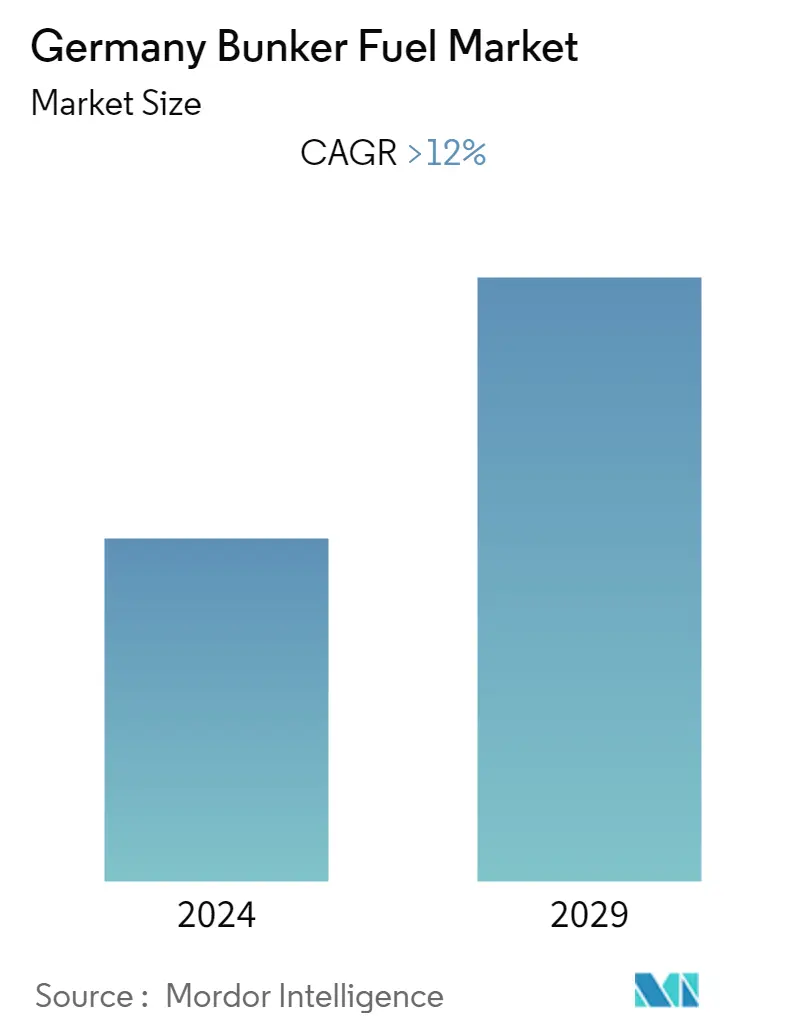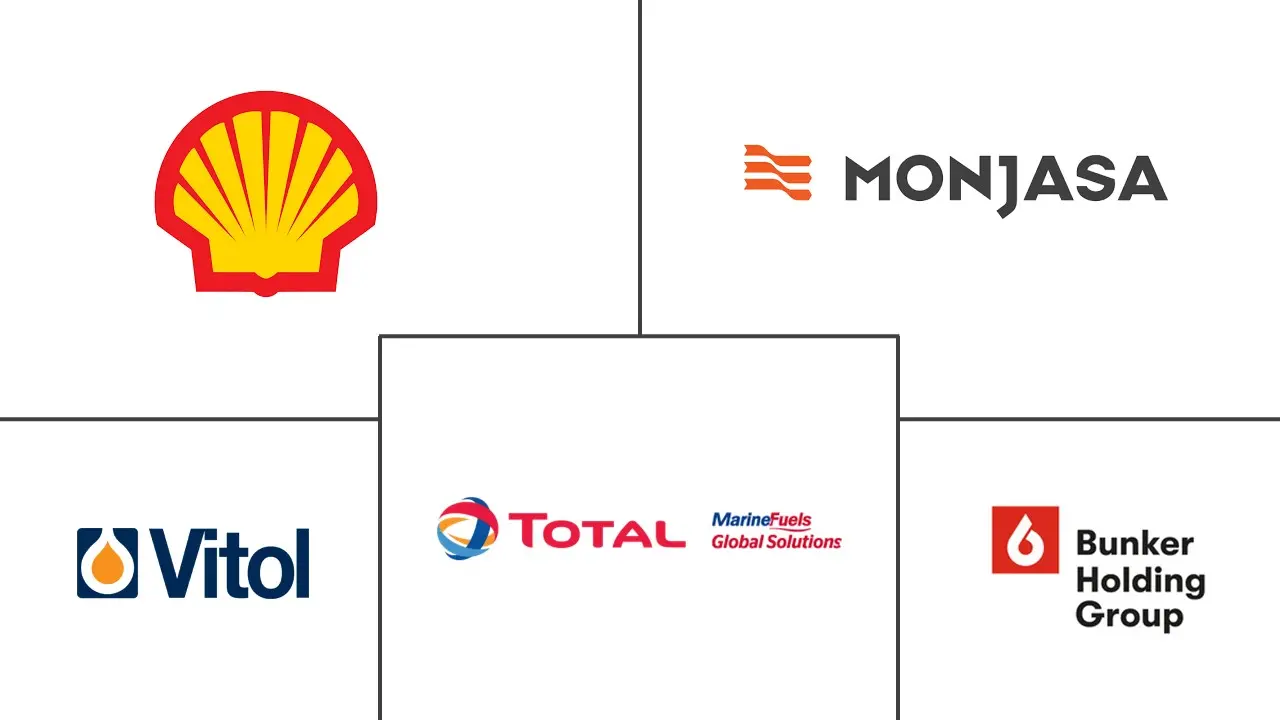Market Size of Germany Bunker Fuel Industry

| Study Period | 2019 - 2029 |
| Base Year For Estimation | 2023 |
| Forecast Data Period | 2024 - 2029 |
| Historical Data Period | 2019 - 2022 |
| CAGR | > 12.00 % |
Major Players
*Disclaimer: Major Players sorted in no particular order |
Germany Bunker Fuel Market Analysis
Germany's bunker fuel market is expected to register a CAGR of more than 12% over the forecast period.
- Over the medium term, the bunker fuel market in the country is mainly driven by the ever-rising marine transportation of essential commodities, the implementation of stricter environmental regulations driving the demand for cleaner bunker fuels, and the increase in the use of marine vessels for offshore oil and gas developments.
- On the other hand, the increasing initiatives regarding reducing fuel usage by the shipping community are likely to hamper market growth in the coming years.
- Nevertheless, Germany has always been a vital shipping nation and is one of the largest shipping countries in the European Union. Creating new sea trade routes and increasing international sea trade could be very good for marine fuel suppliers.
Germany Bunker Fuel Industry Segmentation
Bunker fuel is the general term given to any fuel poured into a ship's bunkers to power its engines. Most deep-sea cargo ships burn the heavy oil that is left over from refining crude oil after gasoline, diesel, and other light hydrocarbons are taken out.
The German bunker fuel market is segmented by fuel type and vessel type. By fuel type, the market is segmented into high-sulfur fuel oil (HSFO), very low-sulfur fuel oil (VLSFO), marine gas oil (MGO), liquefied natural gas (LNG), and others (methanol, LPG, and biodiesel). By vessel type, the market is segmented into containers, tankers, general cargo, bulk containers, and others. For each segment, market sizing and forecasts have been done based on revenue (USD).
| Fuel Type | |
| High Sulfur Fuel Oil (HSFO) | |
| Very Low Sulfur Fuel Oil (VLSFO) | |
| Marine Gas Oil (MGO) | |
| Liquefied Natural Gas (LNG) | |
| Other fuel Types (Methanol, LPG, Biodiesel) |
| Vessel Type | |
| Containers | |
| Tankers | |
| General Cargo | |
| Bulk Container | |
| Other Vessel Types |
Germany Bunker Fuel Market Size Summary
The bunker fuel market in Germany is poised for significant growth, driven by the increasing demand for marine transportation of essential goods and the implementation of stricter environmental regulations. These regulations are pushing the industry towards cleaner bunker fuels, such as very low-sulfur fuel oil (VLSFO), which is becoming more prevalent due to the International Maritime Organization's 2020 regulations. The shift from high-sulfur bunker fuel oil to low-sulfur alternatives is expected to reshape the market landscape, with VLSFO gaining traction as a preferred choice. Despite challenges such as initiatives to reduce fuel consumption by the shipping community, Germany's status as a major shipping nation within the European Union and its strategic sea trade routes continue to bolster the demand for marine fuels.
Germany's robust maritime trade infrastructure, including major ports like Hamburg and Bremen/Bremerhaven, supports its position as a leading sea-trading country. The country's ports are among the top global container hubs, facilitating significant international trade. The government's Maritime Agenda 2025 emphasizes sustainability in maritime trade, aligning with global trends towards reducing sulfur emissions. This focus, coupled with the increasing number of maritime vessels and the development of new bunkering facilities, underscores the growth potential in the bunker fuel sector. Key industry players, including Bunker Holding A/S, Vitol Holding BV, and Royal Dutch Shell Plc, are actively participating in this evolving market, which is characterized by a semi-fragmented competitive landscape.
Germany Bunker Fuel Market Size - Table of Contents
-
1. MARKET OVERVIEW
-
1.1 Introduction
-
1.2 Market Size and Demand Forecast in USD billion, till 2028
-
1.3 Recent Trends and Developments
-
1.4 Government Policies and Regulations
-
1.5 Market Dynamics
-
1.5.1 Drivers
-
1.5.2 Restraints
-
-
1.6 Supply Chain Analysis
-
1.7 PESTLE Analysis
-
-
2. MARKET SEGMENTATION
-
2.1 Fuel Type
-
2.1.1 High Sulfur Fuel Oil (HSFO)
-
2.1.2 Very Low Sulfur Fuel Oil (VLSFO)
-
2.1.3 Marine Gas Oil (MGO)
-
2.1.4 Liquefied Natural Gas (LNG)
-
2.1.5 Other fuel Types (Methanol, LPG, Biodiesel)
-
-
2.2 Vessel Type
-
2.2.1 Containers
-
2.2.2 Tankers
-
2.2.3 General Cargo
-
2.2.4 Bulk Container
-
2.2.5 Other Vessel Types
-
-
Germany Bunker Fuel Market Size FAQs
What is the current Germany Bunker Fuel Market size?
The Germany Bunker Fuel Market is projected to register a CAGR of greater than 12% during the forecast period (2024-2029)
Who are the key players in Germany Bunker Fuel Market?
Bunker Holding A/S , Vitol Holding BV , Total SA , Royal Dutch Shell Plc and Monjasa Holding A/S are the major companies operating in the Germany Bunker Fuel Market.

